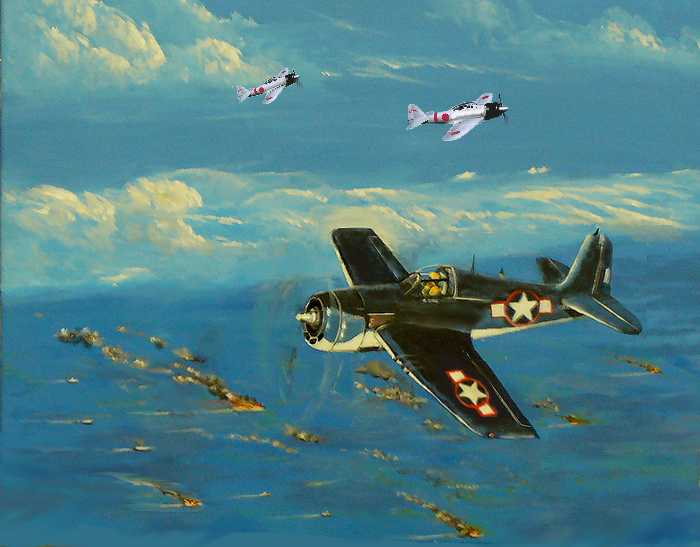This is a recent painting that I thought you might enjoy. It’s called Time to Go, and depicts a sea-air battle in the Pacific. The U.S. plane is the F4F Wildcat which was considered inferior to the Japanese Zero shown in the background. This plane was replaced by the much improved F4U Corsair. Japanese pilots that mistook a Corsair for the old Wildcat got the surprise of their lives. The layers of fog and behind that the high cumulus clouds was a challenge for me, but after some layers of color they finally came out pretty much as I wanted.
The flaming ships don’t show well in this reduction, looks much more real in person, but you get the idea. By the way, I just scored two first place awards at the Silver Dollar Fair for adult amature art. The prize money will be used to buy more paint!


WoW, Jack good job! Well Done 🙂
Congrats Jack! I like this one a lot.
Have you ever considered doing nose art? http://www.nose-art.net/
Nose art is still viable in the private aviation circles. If I could do air brushing I would consider givi9ng it a try. Thanks for the link, some of those paintings are excellent. -Jack
Well done, sir. From your comments on your F4U painting, “If you see any mistakes please tell me!” Only comment I would make is that the wings on both the Corsair and the Wildcat seem to be at about a 10-12 degrees more left bank than the tail surfaces and fuselage. The Zeros are spot on. Again, well done.
The Wildcat was a rugged machine built by Grumman (aka “The Ironworks”). I would argue that their next design, the F6F Hellcat, was the fighter that more directly replaced the Wildcat. Both fighters had very similar profiles, but the Hellcat’s 2000hp Pratt and Whitney R2800 engine gave it vastly superior performance, as described here (part 2 of 4)…
http://www.youtube.com/watch?v=qY8FIjRWEfs
Probably not much chance of mistaking the bent wings of a Corsair (built by Chance-Vought) for those of a Grumman. Initially, the Corsair was restricted to ground bases only. Turns out that the long nose makes a straight-in approach to a carrier deck nearly impossible because for a few precious seconds, the pilot can’t see the ship! That is why when you see film of them landing on a carrier, they approach in a sharp left turn (so the pilot can see) then snap wings level at the last second and execute what is politely called a “controlled crash” landing. This technique was actually pioneered by the British with their Corsairs.
Here is a fascinating story about a Zero captured in Alaska that directly contributed to the development of the Hellcat.
http://en.wikipedia.org/wiki/Akutan_Zero
RHT…you are spot on about the camber difference, thanks for confirming what I have thought. Now it’s really bugging me, how in the heck did that happen and how do I align it better? That is is something I have to work on tonight.
Jack: I am amazed..I had no idea you were this talented. I hope to see more of your paintings…keep them posted.